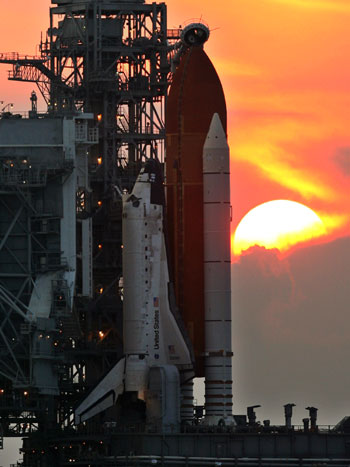Top News
NASA set for first shuttle launch in year
(AP)
Updated: 2006-07-01 21:31
 |
Large Medium Small |
For the first time in almost a year, NASA was set to launch a space shuttle Saturday on a mission that will test whether the space agency has reduced the risks of flying in the 25-year-old vehicles.
 The Space Shuttle Discovery is exposed and prepared for liftoff as the protective Rotating Service Structure is rolled back at sunset in preparation for Mission STS-121 at the Kennedy Space Center in Cape Canaveral, Florida June 30, 2006. The launch is scheduled for July 1. [Reuters] |
Discovery was set to blast off from Kennedy Space Center at 3:49 p.m. EDT, only the second shuttle launch since the Columbia disaster in 2003.
Storm clouds forecast for the afternoon remained the chief obstacle to launch, though a last-minute technical problem popped up Saturday morning. A heater used to keep ice from building on a firing thruster had a higher-than-normal temperature. The countdown proceeded as normal, and NASA was unsure what effect it would have on the launch.
"You need to have all four thrusters in good shape," said Michael Curie, a spokesman for United Space Alliance, the private company that services the shuttle.
The chances of the weather being good enough for a launch improved to 60 percent from 40 percent a day earlier, NASA said Saturday.
Fueling began as scheduled at 6 a.m. During the process, NASA engineers planned to find out if new fuel tank sensors were operating properly. Four sensors designed to prevent the main engines from running too long or not long enough during the climb to space were replaced after one of them gave an electrical reading that was slightly off. The swap-out pushed back Discovery's launch in May.
The launch Saturday will test NASA Administrator Michael Griffin's decision to go ahead with the mission despite the concerns of two top agency managers who fear foam flying off the fuel tank might harm the space shuttle.
Bryan O'Connor, the space agency's chief safety officer, and chief engineer Christopher Scolese recommended at a flight readiness review meeting two weeks ago that the shuttle not fly until further design changes are made to 34 areas on the fuel tank known as ice-frost ramps. These wedge-shaped brackets run up and down the tank holding in place pressurization lines. Foam insulation is used to prevent ice from building up on the tank when it is filled with supercold fuel. Small pieces of foam have snapped off during previous launches.
O'Connor and Scolese agreed with Griffin's rationale that the risk was only to the shuttle and not the crew since the astronauts could take refuge in the international space station until a rescue vehicle is sent up, so they didn't appeal Griffin's decision.
"First of all, it's not a democracy. We don't take a vote. We don't need 100 percent of the people to say it's OK," astronaut Scott Kelly, whose identical twin, Mark, is Discovery's pilot, said of Griffin's decision. "He made the decision and I think it's the right decision to proceed with the launch."
Astronaut Stephen Robinson, who was part of last year's crew that made the first return to flight since Columbia disintegrated in 2003, said he was encouraged that the biggest technical debate was focused on the ice-frost ramps.
"If we're down to worrying about something like an ice-frost ramp, we must be doing a lot of things right," Robinson said. "There are much bigger things to worry about."
NASA engineers redesigned the external fuel tank after the Columbia accident, and again after a 1-pound piece of foam insulation came off the tank during Robinson's mission last year. In the most recent change, more than 35 pounds of foam have been removed in what NASA describes as the biggest aerodynamic change ever made to the shuttle's launch system. NASA tried other design changes to the ice-frost ramps, such as removing foam, but they didn't hold up well in wind tunnel tests.
Discovery's seven-member crew will test shuttle inspection and repair techniques, bring supplies and equipment to the international space station and deliver the European Space Agency's Thomas Reiter for a six-month stay aboard the orbiting outpost.
Astronauts Piers Sellers and Mike Fossum will make two spacewalks and possibly a third, which would add a day to what is planned to be a 12-day mission. The crew also includes commander Steve Lindsey and mission specialists Lisa Nowak and Stephanie Wilson.